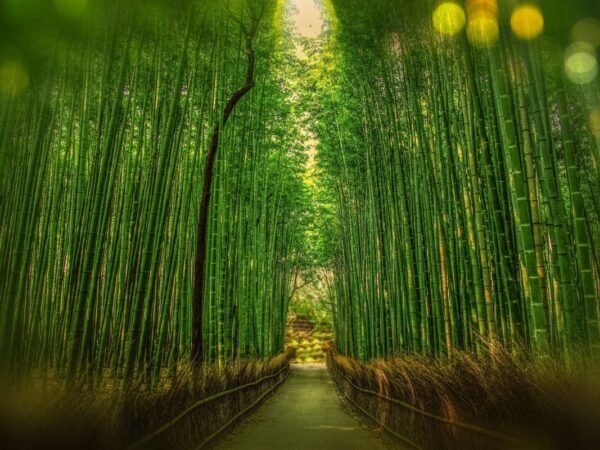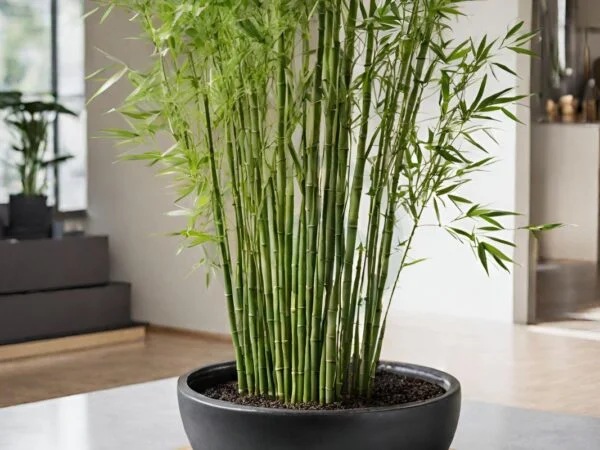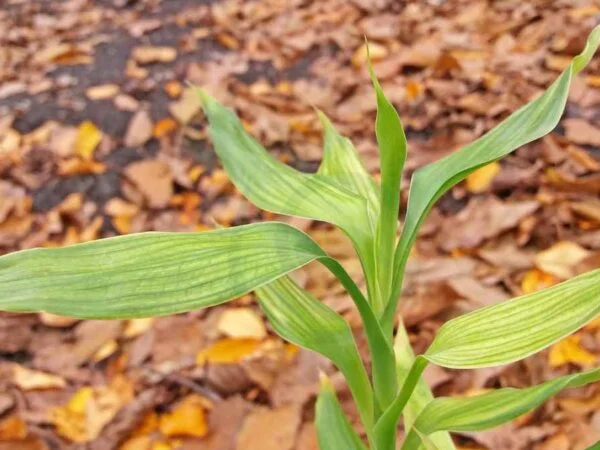So the answer to does bamboo grow in Ohio is absolutely, yes! Given the proper circumstances, you’ll be able to grow this versatile plant successfully in all corners of the state.
Bamboo does very well in soil that drains easily. It adores full sun, which makes it an excellent complement to any garden or landscape. Ohio has a diverse climate, which allows for several species of bamboo to flourish, offering both ornamental beauty and practical uses.
For these reasons, many gardeners love bamboo for its fast-growing nature and because it can make excellent privacy screens or windbreaks. Here are some things I learned that can help you choose the best bamboo varieties for Ohio.
I’ll walk you through how to care for them and all the amazing ways they can enrich your outdoor space.
Key Takeaways
- Selecting the appropriate bamboo species is essential for long-term success in Ohio. Look for cold-hardy varieties such as Rivercane. You can try growing the more ornamental varieties like Yellow Groove to do well with the local climate.
- Ohio’s USDA Hardiness Zone 6 makes it welcoming for bamboo. Understanding how cold winters and frost threats affect your bamboo will help you select the most suitable species for your garden.
- Soil quality is one of the most important factors in successful bamboo growth. Look for loamy, well-draining soils and use compost to increase the nutrient-holding capacity and moisture-retention of soils.
- Winter-protect your bamboo in extreme winters with mulching and wind breaks. Further, you may be able to use anti-desiccant sprays to protect against frost damage as well.
- Connect with existing local bamboo communities, or seek out local bamboo workshops to gain insights from successful bamboo growers across Ohio. Sharing these experiences can provide some of the best insights and create bonds that last far beyond the field.
- Use bamboo to create beautiful landscapes Aesthetically pleasing and environmentally friendly, bamboo can play an important part in sustainable landscaping. It can act as a natural privacy screen and contribute toward beautifying the community, improving local ecosystems and promoting sustainability.
Bamboo Growth in Ohio
Bamboo has the potential to grow successfully in the state of Ohio, but choosing the appropriate species of bamboo is essential. Varieties that are cold-resistant, such as Rivercane, are native to the area and thrive in Ohio’s climate. Ornamental choices like Yellow Groove and Bisset go beyond visual inspiration with characteristics to develop and thrive in your area.
Seek out Dragon Head and Red Margin bamboo for your home gardens. Their ability to survive cold polar vortex winters and loose habit add interest and rugged character to your landscape.
Ohio’s climate, especially its cold winters and danger of late spring/fall frosts, play a big role in bamboo establishment as well. In areas where seasonal temperature fluctuations may put stress on the bamboo, it is important to select species able to withstand these temperature changes.
The abundance of humidity that Ohio provides is a major factor as well. It can determine bamboo’s health and growth cycle.
Bamboo grows best in loamy soils that drain easily, but bamboo is forgiving and thrives on neglect. Preparing your soil with compost can improve nutrient availability to foster strong growth.
Other important soil qualities are proper drainage, moisture retention, and pH balance.
Both summer relief and winter protection strategies are essential. Mulching helps insulate roots during the harshest months, while properly placed windbreaks will protect bamboo from winds that can become quite biting.
Applying anti-desiccant sprays and/or letting ice build up on branches for extra insulation can help.
Bamboo Growth in Colorado
Bamboo can do phenomenally well in Colorado, but understanding the specific challenges and opportunities in bamboo farming is important. The state’s distinct ecology shapes the management of running bamboo and its growth.
1. Environmental Factors Affecting Bamboo
Natural light exposure is crucial for bamboo growth. Bamboo relies heavily on sunlight for growth. Colorado has plenty of bright sunshine that can help bamboo maximize its photosynthesis and growth potential.
Inland, the state can be subject to temperature extremes, with Cheyenne experiencing some winter lows dipping to nearly -30°F. Selecting the appropriate bamboo species able to tolerate and adapt to such temperature swings is critical for success.
Moisture levels are relevant, too. As with any bamboo in arid locales, watering must be closely monitored in dry periods in Colorado’s climate. Bamboo does require some regular moisture, so building irrigation systems or at least water access into designs will ensure healthy robust plants.
Soil composition is very different throughout the whole state. Soil that is well-draining and rich in nutrients will foster the overall health of the bamboo, while heavy clay or sandy soil will inhibit bamboo growth. Testing is the only way to really know what’s there and ensure you’re creating the right conditions.
2. Challenges of Growing Bamboo in Colorado
Even with great promise, bamboo growers hit a wall of uncertainty. Since growth is drastically affected by drought, we need to be planning for practices that are drought resistant from the start.
Pests and diseases, like aphids or bamboo blight, can be a concern for bamboo growers, requiring proactive pest management. Soil types can be a restriction on growth too.
Many sites will have compacted or otherwise bad soil conditions that will need to be amended in order to successfully grow bamboo. Smart comprehensive planning and expert management are absolutely essential for bamboo to be cultivated correctly and successfully in Colorado’s urban and rural communities.
Regions Where Bamboo Thrives in the U.S.
Bamboo is incredibly adaptable, growing in nearly any climate or soil, making it a fantastic choice for a bamboo garden.
1. Climate Zones for Bamboo Growth
Bamboo generally grows best in USDA hardiness zones 5 through 10. In Zone 5, Ohio is booming with healthy stands of dry, hardy runners like Fargesia. In Zones 7 to 10, which encompass Florida and most of California, are perfect for more tropical species, like Bambusa.
Each zone consists of designated temperature ranges, which directly correlate to the ability for bamboo to thrive. The key to any successful cultivation lies in understanding one’s specific climate zones. Understanding if you live in a temperate or subtropical region will aid you in selecting species that will fare best.
2. Soil Requirements Across Different Regions
Bamboo thrives in well-draining, loamy soil that’s further enriched with organic matter. To grow as well as possible, bamboo prefers soil with a pH between 6.0 and 7.0, retentive of moisture, and well-aerated.
Areas with clay-intensive soil will likely need to amend the soil to improve drainage and nutrient levels. Soil tests help you get a sense of what soil health looks like in your area. Incorporating compost or mulch into the planting soil will go a long way toward preparing healthy growing conditions for bamboo.
Conclusion
Whether you choose hardy clumping bamboo or invasive running varieties, bamboo is an exciting and beautiful addition to your Ohio garden. This vigorous plant grows well almost everywhere, and Ohio’s climate is particularly suited for it. You can appreciate its density and aesthetic character without putting in a lot of effort. Whether you’re looking for privacy, a windbreak or a little bit of the exotic, bamboo delivers.
If you’re ready to start your bamboo journey today, learn more here. Given a little TLC, you can turn your indoor or outdoor area into a lush, green paradise. Learn with us and learn how this awesome resource can benefit you. You’ll experience the delight of seeing it thrive and beautiful, imparting interest to your garden. Let’s cultivate together and make beautiful things blossom in your own backyard.
Frequently Asked Questions
Does bamboo grow well in Ohio?
The answer is yes; even the cold-hardy species of bamboo, like running bamboo, can be a spectacular, pheasant-friendly addition to Ohio. However, it takes just the right care and protection, especially against our severe Ohio winters, for these plant species to truly thrive.
What types of bamboo are suitable for Ohio?
Cold-hard bamboo species such as Fargesia and Phyllostachys are definitely worth considering for Ohio’s climate, as these plant species can thrive in poor soil conditions and withstand cooler temperatures.
How much sunlight does bamboo need in Ohio?
Bamboo thrives in full sun but can tolerate some shade; ensure it receives 6 or more hours of sunlight each day for optimal growth in your bamboo garden.
When is the best time to plant bamboo in Ohio?
The ideal time to plant bamboo in Ohio would be spring after the last frost, as this timing supports good root development for various bamboo species.
How do I care for bamboo in Ohio?
Water bamboo regularly and consider using mulch around your bamboo garden to help retain moisture. Fertilize these plants during their active growing season and prune hard to prevent spindliness, ensuring a bushy appearance.
Can bamboo survive Ohio winters?
Indeed, some types of running bamboo are hardy enough to withstand Ohio winters. As with many plant species, winter protection or growing them under a canopy of larger, established trees can help them withstand the coldest of temps.
Is bamboo invasive in Ohio?
So why should you be concerned about invasive plants like bamboo? Some bamboo species can be invasive due to their rapid growth, making bamboo management essential. Choosing clumping types helps control their spread effectively.
Image Source: Paid image from CANVA





